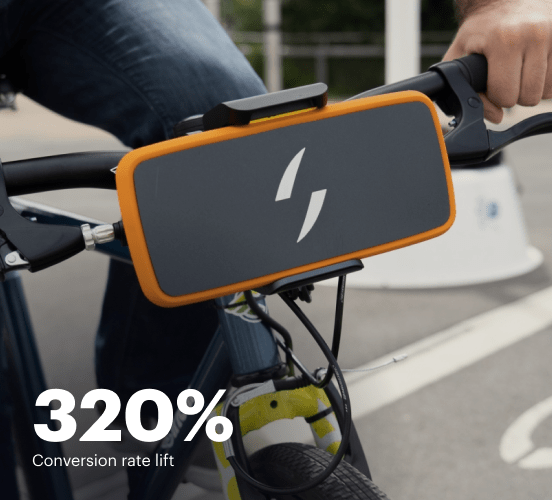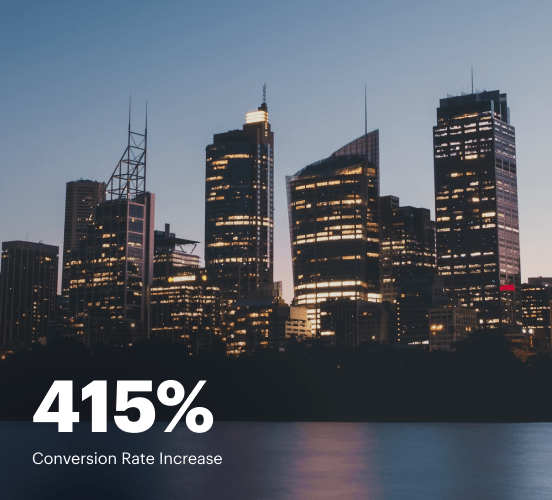How Pixpa vs. Shopify vs. Instapage stack up against each other
Compare Instapage with Pixpa and Shopify to create high-converting landing pages. With personalization, optimization, and collaboration tools, Instapage helps you deliver experiences that drive results.
Get startedSee how Instapage stacks up against the competition
| Feature | Instapage | Other builders |
| Drag-and-Drop Tools | ||
| Conversion-optimized templates | ||
| Manual and AI-powered A/B Tests | ||
| AI content suggestions | ||
| Popups and sticky bars | ||
| Canvas and grid blocks | ||
| Reusable and global elements | ||
| Form and popup builders | ||
| Built-in Heatmaps | ||
| Central analytics dashboard | ||
| Ad-to-page personalization and collections | ||
| Contacts, lists, and email | ||
| Dedicated, full-service CRO experts | ||
| Enterprise-ready platform |
Leading the way in building high-performing landing pages





Why Instapage is the smarter choice for your campaigns
Get everything you need to build, scale, and optimize high-converting landing pages—without coding.

Easier page building without coding
Instapage offers a flexible and seamless page creation experience with a library of 500+ conversion-focused layouts, Instablocks®, a drag-and-drop builder, and AI content generation. With technologies like Thor Render Engine®, you can create on-brand, mobile-responsive landing pages that load quickly and start converting during initial visitor clicks.

More insights — better results
Instapage lets you see in detail how each landing page experience and variation is performing so you can make targeted changes that boost page conversions. Use heatmaps for a better understanding of on-page activities, run A/B tests and AI-assisted experiments, and then track and evaluate results within robust analytics dashboards.

More personalized experiences
Instapage lets you quickly create high-performing landing pages tailored to each of your ad campaigns. Deliver personalized experiences for distinct audiences using dynamic text replacement. Effortlessly align specific advertisements to unique pages with AdMaps. Monitor audience-level metrics using our advanced data tools.

Built-in collaboration
Instapage collaboration capabilities bring your entire team together to speed up the process of landing page review, approval, and launch. No more frustrating and unnecessary revisions or edits scattered across emails. Provide instant feedback, conduct real-time page edits, and securely share your pages with outside stakeholders.

Free up time for your business
Invest time into business growth, not busy work. Launch landing pages faster with reusable forms and templates. Build once, reuse forever.
Explore all integrations






Easier page building without coding
Instapage offers a flexible and seamless page creation experience with a library of 500+ conversion-focused layouts, Instablocks®, a drag-and-drop builder, and AI content generation. With technologies like Thor Render Engine®, you can create on-brand, mobile-responsive landing pages that load quickly and start converting during initial visitor clicks.
More insights — better results
Instapage lets you see in detail how each landing page experience and variation is performing so you can make targeted changes that boost page conversions. Use heatmaps for a better understanding of on-page activities, run A/B tests and AI-assisted experiments, and then track and evaluate results within robust analytics dashboards.
More personalized experiences
Instapage lets you quickly create high-performing landing pages tailored to each of your ad campaigns. Deliver personalized experiences for distinct audiences using dynamic text replacement. Effortlessly align specific advertisements to unique pages with AdMaps. Monitor audience-level metrics using our advanced data tools.
Built-in collaboration
Instapage collaboration capabilities bring your entire team together to speed up the process of landing page review, approval, and launch. No more frustrating and unnecessary revisions or edits scattered across emails. Provide instant feedback, conduct real-time page edits, and securely share your pages with outside stakeholders.
Free up time for your business
Invest time into business growth, not busy work. Launch landing pages faster with reusable forms and templates. Build once, reuse forever.
Explore all integrationsGet started with Instapage in a few steps
-
Create your Instapage account
Start with Instapage by signing up via Google or your email. You'll get access to a free 14-day trial to discover Instapage capabilities. Feel free to cancel anytime during the 14-day trial if you decide that our product is not suitable for your business. -
Build and personalize your page
Create your first landing page from scratch or choose a template from 500+ customizable layouts. Use the drag-and-drop builder to add page elements, fonts, and backgrounds, refine content with AI, or add custom HTML, Javascript, and CSS. -
Review and make edits
Collaborate on page designs and streamline review processes. Invite your team members and stakeholders to review, edit, and provide feedback on your landing page. Collaborate knowing your page is confidential and only accessible to authorized users. -
Publish and track page performance
Publish your page to a domain or custom URL. Connect your pages to the ads you've created and track page performance within the analytics dashboard, run A/B tests and AI experiments, analyze results, and continuously optimize your landing page to maintain high conversions.
Instapage vs. Pixpa vs. Shopify – Which One to Choose for Your Business?
Choosing the right landing page builder can be likened to assembling your dream team for a big project. Each platform brings unique skills to the table, just like superheroes with their special powers. Instapage, Pixpa, and Shopify are three contenders that promise to uplift your marketing strategies with innovative features and robust functionalities. In this showdown, we’ll explore why Instapage stands out as the ultimate option for marketers looking to create high-converting landing pages. With the aim of cutting costs, boosting conversions, and delivering personalized landing page experiences, Instapage empowers businesses to increase brand trust and customer loyalty. So, gear up as we dive into the arena of landing page builders, unmasking what each contender has to offer, starting with an overview of our three competitors.
Meet the Contenders: A Quick Introduction
In the red corner, we have Instapage, known for its advanced landing page capabilities that are designed specifically for marketers. With its user-friendly interface and powerful features, Instapage aims to assist users in crafting landing pages that are not only visually appealing but also optimized for conversions. In the blue corner, Pixpa comes into play, appealing to creative professionals with its all-in-one website builder and portfolio features. It focuses on providing aesthetic templates and e-commerce integrations. Finally, in the green corner, we have Shopify, a giant in the e-commerce world that offers simple solutions for building a store, but also steps into the realm of landing pages. While all three platforms boast admirable strengths, the nuances of each can deeply impact your choices in optimizing online experiences and conversions.
Round One: Features Comparison
Template Variety and Ease of Use
When it comes to features, having a wide range of templates can make or break a landing page's effectiveness. Instapage offers over 200 customizable templates crafted for various industries, allowing users to kick-start their designs without starting from scratch. Its drag-and-drop editor ensures effortless customization, making it incredibly user-friendly even for novices. In comparison, Pixpa provides around 60 creative templates which, while visually striking, may not offer the same level of customization depth that Instapage delivers. Meanwhile, Shopify provides various templates as well, primarily built to cater to e-commerce needs. However, its focus is largely on product listings and less on standalone landing pages. As for ease of use, Instapage stands out for its intuitive interface, while Pixpa and Shopify require a bit of a learning curve, especially for those unfamiliar with website design.
Instapage: A Leader in Customization and Conversion Tools
Instapage shines when it comes to conversion optimization tools. Beyond just beautiful templates, it is equipped with A/B testing capabilities, dynamic text replacement, and heat mapping features that allow marketers to analyze user interactions. These tools help refine landing pages to maximize conversions, making it a vital partner in any marketing strategy. Instapage's focus on user experience is paramount, ensuring that every element from design to functionality contributes to higher conversion rates. Additionally, its dedicated post-launch optimization tools provide insights that are invaluable for continuous improvement, solidifying its position as an essential asset for marketers aiming to boost ROI.
Round Two: Speed and Performance – Who's the Fastest?
Imagine you're at a coffee shop, and you're waiting for your order, feeling your patience wane as each moment ticks by. This slow loading time is just as frustrating on a website, leading to potential lost conversions. Speed is crucial, and in this round, we will analyze how each platform measures up. Both Instapage and Shopify boast faster loading times due to optimized back-end processes, ensuring users don't have to wait long for content to appear. Pixpa, while generally reliable, can sometimes face slowness during peak hours due to shared server resources. Let's break down how each platform stacks up in terms of performance and speed.
Instapage Advantages in Speed and Performance:
- Utilizes a global content delivery network (CDN) for quicker load times
- Optimized for mobile devices to ensure instant access
- Built with lightweight code to enhance performance
- Regular updates to improve backend processes and reduce downtime
Pixpa Advantages in Speed and Performance:
- Generally provides stable speeds for creative portfolio sites
- Includes automatic image optimization for faster loading
- Offers built-in caching to improve site performance
Shopify Advantages in Speed and Performance:
- Inherently built for e-commerce, ensuring quick response times
- Scalable architecture that accommodates high traffic
- Optimizations for product pages help improve loading speeds
- Uses powerful infrastructure to manage store loading efficiently
In conclusion, speed and performance play a vital role in how effectively each platform functions. Instapage leads the pack, ensuring that users and potential customers have a seamless browsing experience. This focus on performance connects directly to higher conversion rates, underscoring Instapage’s competitive edge when compared to Pixpa and Shopify.
Round Three: Usability and the Learning Curve
Every platform wants to make a positive first impression, especially for beginners exploring the world of landing page creation. Instapage prides itself on its user-friendly setup, allowing newcomers to jump right in with ease. With tutorials and intuitive navigation, users can quickly familiarize themselves with the various functionalities. Pixpa caters to its creatives through a visually-focused interface, but users may find themselves toggling through features that require a bit of learning. Shopify, although straightforward for e-commerce tasks, can pose challenges for users solely focused on landing pages due to the numerous features related to store management. Regardless of past experience, each platform ultimately aims to nurture its users through to expert-level control, but Instapage leads the charge in making the journey smooth and enjoyable.
Round Four: Support and Assistance
Imagine each platform’s customer support staff as trusty sidekicks, ready to swoop in when challenges arise. Instapage offers a variety of support options, including live chat, email, and an extensive knowledge base brimming with insights and guidelines. The community forum also provides a space for users to share strategies and solutions. Pixpa offers similar features but lacks the immediacy of live support, leaning more on email communication and a comprehensive library of articles. On the other hand, Shopify's customer support is robust, with 24/7 assistance through chat and email. Its rich ecosystem creates opportunities for learning and problem-solving. However, Instapage's combination of responsiveness and extensive resources places it a step ahead as the ultimate support companion.
Round Five: Pricing and Plans – Getting the Best Value
In the final round, let’s talk numbers. Pricing structures can be as varied as the platforms themselves. Instapage operates on a subscription model, offering various tiers based on features and user access. While initially higher in price compared to some competitors, the ROI gained through increased conversions justifies the value offered. Pixpa also follows the subscription path but features fewer plans that support creative portfolios. Shopify typically appeals to e-commerce users with its basic store package, which might seem attractive, but additional costs for apps and themes can add up quickly. Therefore, when assessing value, it’s crucial to align the pricing plan with specific goals. Each platform has strengths, but Instapage's tailored services often translate to a better investment for marketers keen on amplifying their landing page game. Reflecting on every factor discussed brings us to the conclusion that the right choice hinges on individual needs and aspirations.
In wrapping up this comparison, we recognize that Instapage offers superior features related to landing page creation, making it an ideal choice for marketers looking to enhance their conversion rates. Pixpa may serve creative professionals well, while Shopify markets primarily to online sellers. Assess your unique objectives and determine what you prioritize in a landing page builder, whether it’s features, speed, support, or pricing flexibility. To truly understand Instapage's potential, consider trying out its free trial or demo—experience firsthand how it can elevate your marketing efforts.










